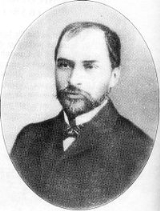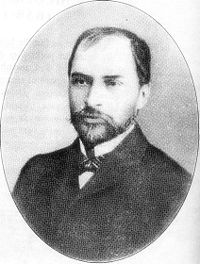
George Cosbuc
Encyclopedia

Cosbuc, Bistrita-Nasaud
Coşbuc is a commune in Bistriţa-Năsăud County, Romania. Since the village of Bichigiu was transferred to Telciu commune in 2004, Coşbuc remains the commune's only village.The poet George Coşbuc was born here in 1866....
in Bistriţa-Năsăud County
Bistrita-Nasaud County
Bistrița-Năsăud is a county of Romania, in Transylvania, with the capital city at Bistrița.-Demographics:In 2002, it had a population of 311,657 and the population density was 58/km².*Romanians – 90.3%*Hungarians – 5.9%*Roma – 3.6%...
—May 9, 1918, Bucharest
Bucharest
Bucharest is the capital municipality, cultural, industrial, and financial centre of Romania. It is the largest city in Romania, located in the southeast of the country, at , and lies on the banks of the Dâmbovița River....
) was a Romania
Romania
Romania is a country located at the crossroads of Central and Southeastern Europe, on the Lower Danube, within and outside the Carpathian arch, bordering on the Black Sea...
n poet, translator, teacher, and journalist, best remembered for his verses describing, praising and eulogizing rural life, its many travails but also its occasions for joy.
Although his work was later coopted by Communist
Communist Romania
Communist Romania was the period in Romanian history when that country was a Soviet-aligned communist state in the Eastern Bloc, with the dominant role of Romanian Communist Party enshrined in its successive constitutions...
propagandists to embellish Marxist-Leninist
Marxism-Leninism
Marxism–Leninism is a communist ideology, officially based upon the theories of Marxism and Vladimir Lenin, that promotes the development and creation of a international communist society through the leadership of a vanguard party over a revolutionary socialist state that represents a dictatorship...
rhetoric marginalizing intellectuals while emphasizing "the alliance between peasants and the laboring class", he is still widely regarded as a master of verse, accomplished translator and loving chronicler of the Romanian human and geographical topography.
Early life
His father Sebastian Coşbuc, a Greek CatholicRomanian Church United with Rome, Greek-Catholic
The Romanian Church United with Rome, Greek-Catholic is an Eastern Catholic Church which is in full union with the Roman Catholic Church. It is ranked as a Major Archiepiscopal Church and uses the Byzantine liturgical rite in the Romanian language....
priest looked up to by his parish, drew from a line reputed to have yielded fourteen consecutive generations of priests. George attended primary school and graduated to secondary classes in the neighboring village of Telciu
Telciu
Telciu is a commune in Bistriţa-Năsăud County, Romania. It is composed of four villages: Bichigiu , Fiad , Telcişor and Telciu.-External links:...
. He happily took to the scholarly bent encouraged by his father, earning the praise of instructors and being chosen among the few who were to sign up for advanced courses at Liceul Românesc (The Romanian Lyceum
Lyceum
The lyceum is a category of educational institution defined within the education system of many countries, mainly in Europe. The definition varies between countries; usually it is a type of secondary school.-History:...
), a higher learning academy in the town of Năsăud
Nasaud
Năsăud is a town in Bistriţa-Năsăud County in Romania located in the historical region of Transylvania. The town administers two villages, Liviu Rebreanu and Luşca.The name Năsăud is possibly derived from the Slavic nas voda, meaning "near the water"...
. He soon found himself doubling as teacher.
He began tearing through the library of the institution, impressing colleagues with his encyclopedic inclinations, and joined a local literary club, the Virtus Romana Rediviva, an association his father frowned upon as a deviation for a prospective career as clergyman. In 1884, already a well-loved teacher at the age of 24, he published his very first poems in the yearly almanac of the literary club.
First works
Coşbuc began attending courses at the University of ClujBabes-Bolyai University
The Babeș-Bolyai University in Cluj-Napoca is an university in Romania. With almost 50,000 students, the university offers 105 specialisations, of which there are 105 in Romanian, 67 in Hungarian, 17 in German, and 5 in English...
in 1884, while collecting fairy tales and popular stories, which he rewrote and published to local success. He became so popular that three years later, he was asked to become editor in chief of the main Cluj
Cluj-Napoca
Cluj-Napoca , commonly known as Cluj, is the fourth most populous city in Romania and the seat of Cluj County in the northwestern part of the country. Geographically, it is roughly equidistant from Bucharest , Budapest and Belgrade...
newspaper, Tribuna.
He soon published what widely became known as his foremost masterpiece, Nunta Zamfirei ("Zamfira's Wedding") to enthusiastic praise in Romanian literary circles. He moved to Bucharest, capital of Romania
Romania
Romania is a country located at the crossroads of Central and Southeastern Europe, on the Lower Danube, within and outside the Carpathian arch, bordering on the Black Sea...
and the center of cultural discourse. His contributes to the periodical Convorbiri Literare to consistent acclaim. In collaboration with other former educators, he pieced together a praised Romanian language
Romanian language
Romanian Romanian Romanian (or Daco-Romanian; obsolete spellings Rumanian, Roumanian; self-designation: română, limba română ("the Romanian language") or românește (lit. "in Romanian") is a Romance language spoken by around 24 to 28 million people, primarily in Romania and Moldova...
textbook: Carte românească de citire (the "Romanian Book of Reading").
1890s
In 1893, he published Balade şi idile ("Ballads and Pastorals") a volume which cemented his reputation. He began dabbling in poetry with political subtext, penning the emphatic Noi vrem pământ ("We Demand Land"), Lupta vieţii ("Life's struggle"), and overviewes the debut of yet another literary magazine, Vatra. In 1895, he married Elena Sfetea.He completed the first Romanian translation of Virgil
Virgil
Publius Vergilius Maro, usually called Virgil or Vergil in English , was an ancient Roman poet of the Augustan period. He is known for three major works of Latin literature, the Eclogues , the Georgics, and the epic Aeneid...
's Aeneid
Aeneid
The Aeneid is a Latin epic poem, written by Virgil between 29 and 19 BC, that tells the legendary story of Aeneas, a Trojan who travelled to Italy, where he became the ancestor of the Romans. It is composed of roughly 10,000 lines in dactylic hexameter...
in 1896, and also published a collection of various poems and short stories, Versuri şi proză ("Verses and Prose"). His output as a translator is astonishing: within the span of three years, he published large portions of Kalidassa's Sanskrit
Sanskrit
Sanskrit , is a historical Indo-Aryan language and the primary liturgical language of Hinduism, Jainism and Buddhism.Buddhism: besides Pali, see Buddhist Hybrid Sanskrit Today, it is listed as one of the 22 scheduled languages of India and is an official language of the state of Uttarakhand...
Abhignānashākuntala (a part of them through German
German language
German is a West Germanic language, related to and classified alongside English and Dutch. With an estimated 90 – 98 million native speakers, German is one of the world's major languages and is the most widely-spoken first language in the European Union....
translations), and a new Romanian translation of Homer
Homer
In the Western classical tradition Homer , is the author of the Iliad and the Odyssey, and is revered as the greatest ancient Greek epic poet. These epics lie at the beginning of the Western canon of literature, and have had an enormous influence on the history of literature.When he lived is...
's Odyssey
Odyssey
The Odyssey is one of two major ancient Greek epic poems attributed to Homer. It is, in part, a sequel to the Iliad, the other work ascribed to Homer. The poem is fundamental to the modern Western canon, and is the second—the Iliad being the first—extant work of Western literature...
. Coşbuc also undertook the translation of various works by Friedrich Schiller
Friedrich Schiller
Johann Christoph Friedrich von Schiller was a German poet, philosopher, historian, and playwright. During the last seventeen years of his life , Schiller struck up a productive, if complicated, friendship with already famous and influential Johann Wolfgang von Goethe...
. The Romanian Academy
Romanian Academy
The Romanian Academy is a cultural forum founded in Bucharest, Romania, in 1866. It covers the scientific, artistic and literary domains. The academy has 181 acting members who are elected for life....
deemed him an "outstanding member" in 1898. He further contributed to literature by completing, a decade later, the epic effort of translating Dante Aligheri's Divine Comedy in its entirety.
Later life
In December 1901, he joined Alexandru VlahuţăAlexandru Vlahuta
Alexandru Vlahuţă was a Romanian writer. His best known work is România pitorească, an overview of Romania's landscape in the form of a travelogue. He was also the main editor of Sămănătorul magazine, alongside George Coşbuc....
in founding and, until 1905, editing the influential magazine Sămănătorul
Sămănătorul
Sămănătorul or Semănătorul was a literary and political magazine published in Romania between 1901 and 1910. Founded by poets Alexandru Vlahuţă and George Coşbuc, it is primarily remembered as a tribune for early 20th century traditionalism, neoromanticism and ethnic nationalism...
, a traditionalist publication appealing to those intellectuals who could claim peasant roots.
After more than a decade of tremendous success as an author, he experienced personal tragedy in 1915, when his only son, Alexandru, died in a car accident. Heartbroken, Coşbuc ceased all work. He is buried at Bellu
Bellu
Bellu is the most famous cemetery in Bucharest, Romania.It is located on a plot of land donated to the local administration by Baron Barbu Bellu...
cemetery.

